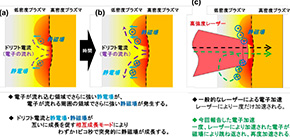
Electron acceleration enhanced via laser-plasma interaction
A group of researchers from Osaka University, Hiroshima University, and Peking University found that electron acceleration was enhanced by more than 4 times in multi-picosecond (multi-ps) laser experiments using a high-intensity laser from Laser for Fast Ignition Experiment (LFEX). The duration of 4.0 ps in this experiment is about 10 times the duration of conventional electron acceleration using a sub-ps laser pulse.
Laser plasma accelerators for irradiating plasma with a high-intensity laser can produce beams with a higher peak intensity than conventional accelerators. Tightening competition surrounding laser intensity for increasing acceleration energy has increased the burden on accelerator systems.
When a material is irradiated with a high-intensity laser pulse, its surface is instantaneously ionized, and the electrons in the ionized material, i.e., plasma, are then accelerated to nearly the speed of light by the ponderomotive force of the laser light. This group generated a sudden kilo-tesla magnetic field in plasma, increasing electron acceleration by more than 4 times under constant irradiation of materials with a high-intensity laser.
Laser accelerators, which can produce beams with a higher peak intensity, are being studied across the world. A sudden growth of quasi-static magnetic fields is observed through the following process:
1. In plasma heated by laser, the E×B drift current, a plasma fluid perpendicular and parallel to a magnetic field, is present.
2. In a region where electrons are injected by the E×B drift current, a stronger static electric field is generated.
3.A static magnetic field is enhanced around the E×B drift current according to the same principle as a magnetic field generated around a wire.
4.The enhanced static electric field produces a stronger E×B drift current.
While repeating the above steps, positive feedback is produced between the growth of the fields and the E×B drift current. The positive feedback results in the rapid growth of the kilo-tesla quasi-static electric and magnetic fields. While kilo-tesla magnetic fields are extremely rare on Earth, stellar magnetic fields are kilo-tesla magnetic fields.
In this study, computer simulations demonstrated that a sudden growth of kilo-tesla magnetic fields triggered the loop-injected direct acceleration (LIDA) process as the dominant acceleration mechanism. This group also derived an equation for calculating the laser pulse duration (pulse width) in efficient electron acceleration. This equation allows one to easily determine the laser pulse duration necessary for efficient electron acceleration without the help of computer simulations. This group’s achievements will lead to the realization of laser nuclear fusion and the application of small medical ion accelerators.

Figure 1
The article, “Electromagnetic field growth triggering super-ponderomotive electron acceleration during multi-picosecond laser-plasma interaction,” was published in Communications Phyisics at DOI: https://doi.org/10.1038/s42005-019-0197-6 .
